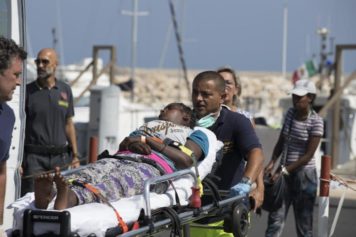A report by Human Rights Watch has revealed evidence of far more waterboarding of detainees after 9/11 under the Bush administration than had previously been acknowledged, including the CIA handing prisoners over to Moammar Gadhafi in Libya, where they were tortured even more.
The 154-page report focuses on the experiences of 14 Libyan dissidents, who describe systematic abuses while they were in U.S. custody in Afghanistan, Pakistan, Morocco, Thailand, Sudan and elsewhere before they were handed over to Gadhafi in Libya.
“Not only did the U.S. deliver (Gadhafi) his enemies on a silver platter, but it seems the CIA tortured many of them first,” said Laura Pitter, counterterrorism adviser at Human Rights Watch and author of the report.
“The scope of the Bush administration abuse appears far broader than previously acknowledged,” she said.
Ironically the report was released just days after the Obama Justice Department announced that it had chosen not to bring any criminal charges against CIA personnel over torture methods used during interrogations. They said investigators couldn’t prove interrogators went beyond authorized Bush administration guidelines.
According to former President George Bush and Vice President Dick Cheney, waterboarding was authorized on only three senior al-Qaeda suspects at secret CIA black sites in Thailand and Poland — Khaled Sheikh Mohammed, Aby Zubayda and Abd al-Rahman al-Nashiri, all currently being held at Guantanamo Bay, Cuba.
But the Human Rights Watch report indicates that the number of tortured suspects was far more than those three. The 14 Libyans were mostly members of the anti-Gadhafi Libyan Islamic Fighting Group that fled in the 1980s and 1990s to Pakistan, Afghanistan and African countries. The group ran training camps in Afghanistan at the same time that al-Qaeda was based there, but it was mor interested in fighting Gadhafi than joining with Osama bin Laden and his campaign of terror against the United States.
In the strange twists of international diplomacy in the shadowy world of the CIA, after sending the detainees back to Gadhafi, the U.S. turned around and helped the Libyan opposition overthrow Gadhafi in 2011. Now several of the 14 former detainees hold positions in the new Libyan government.
In the report, the accounts of the new uses of simulated drowning known as waterboarding came from two former detainees, Mohammed al-Shoroeiya and Khaled al-Sharif. The two men described their abuses: In Afghanistan, they were shackled in cells for months in variety of positions, often naked in almost total darkness with music blaring continuously, left to defecate and urinate on themselves.
Al-Sharif said he spent three weeks seated on the ground in his cell with his ankles and wrists chained to a ring in the wall, forcing him to keep his arms and legs elevated. He said he was taken out of his shackles once a day for a half-hour to eat.
For the first three months, they were not allowed to bathe.
“We looked like monsters,” al-Shoroeiya said.
Al-Shoroeiya described being locked naked for a day and a half in a tall, narrow, half-meter-wide (1 1/2-foot-wide) chamber with his hands chained above his head, with no food as Western music blasted loudly from speakers next to his ears the entire time.
At another point, he was stuffed into a 1 meter by 1 meter (3 foot by 3 foot) box resembling a footlocker and kept there for more than an hour as interrogators prodded him with long, thin objects through holes in the side of the box.
Both he and Sharif said they were repeatedly taken to a room where they were slammed against a wooden wall and punched in the abdomen.
Al-Shoroeiya said one female American interrogator told him, “Now you are under the custody of the United States of America. In this place there will be no human rights. Since September 11, we have forgotten about something called human rights,” according to the report.
Al-Shoroeiya described being waterboarded, though he did not use the term. He said he was put in a hood and strapped upside down on a wooden board. Freezing water was poured over his nose and mouth until he felt he was suffocating. During several half-hour interrogation sessions, they would waterboard him multiple times, asking him questions in between while a doctor monitored his body temperature.
“They wouldn’t stop until they got some sort of answer from me,” he told HRW.
Al-Sharif described a similar technique. Instead of being strapped to a board, he was put on a plastic sheet with guards holding up the edges, while freezing water was poured over him, including onto his hooded face directly over his mouth and nose.
“I felt as if I were suffocating,” he told HRW. “I spent three months getting interrogated heavily … and they gave me a different kind of torture every day. Sometimes they used water, sometimes not.”
Asked about the new accounts, CIA spokeswoman Jennifer Youngblood said the agency “has been on the record that there are three substantiated cases” of the use of waterboarding.
She said she could not comment on the specific allegations but noted the Justice Department’s decision not to prosecute after it “exhaustively reviewed the treatment of more than 100 detainees in the post-9/11 period — including allegations involving unauthorized interrogation techniques.”
The Obama administration has ordered a halt to waterboarding and many of the severe techniques authorized by its predecessors.
Others of the 14 former detainees in the Human Rights Watch described similar conditions as al-Shoroeiya and al-Sharif, particularly three held in the same U.S.-led prisons in Afghanistan.
One of them, Majid Mokhtar Sasy al-Maghrebi, said he nearly went insane in isolation after months being shackled naked in dark, freezing cells with music blaring, pounding his head against the wall and screaming, “I want to die, why don’t you just kill me?”
Another, detained in Mauretania, said that during interrogations by a foreigner he believed was American, his wife was brought to the detention center; his captors showed him his wife through a peephole and threatened to rape her if he did not cooperate.
Human Rights Watch said the U.S. failed in its post-9/11 campaign to distinguish between Islamists targeting the United States and those who “may simply have been engaged in armed opposition against their own repressive regimes.
“This failure risked aligning the United States with brutal dictators,” the report said.
Eight of those interviewed were handed over to Libya in 2004 — the same year then-British Prime Minister Tony Blair made a public rapprochement with Gadhafi and Anglo-Dutch oil giant Shell signed a major exploration deal off the Libyan coast, the HRW report noted. The remaining six were transferred to Libya over the two following years.
All were jailed by Gadhafi’s regime, most of them freed only after his fall. Most said they were not physically tortured — perhaps a result of Gadhafi’s attempts to mend fences with the West — but were kept in solitary confinement for long periods. Several, however, told HRW they were beaten and tortured, including being given electrical shocks.


